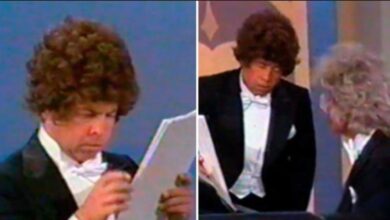The Osmonds’ ‘Down By The Lazy River’ Sparks a Youthquake in 1972, Uniting Rock, Pop, and Family Harmony
When The Osmonds released Down By The Lazy River in January 1972, few could have predicted just how far the song’s explosive energy would travel. Bold, rebellious, and pulsating with attitude, it was a sharp departure from the group’s clean-cut pop beginnings. Peaking at number four on the Billboard Hot 100 and reaching number three on the UK Singles Chart, the track became a transatlantic hit, solidifying the band’s presence in the rock-pop crossover space. It captured the spirit of a restless generation, all while being delivered by a band that was, paradoxically, built on old-fashioned family values.
The Osmonds originated in Ogden, Utah, a family act that began as a barbershop quartet consisting of brothers Alan, Wayne, Merrill, and Jay. Their fame blossomed early thanks to regular appearances on The Andy Williams Show during the 1960s. However, as the cultural tides shifted in the late ’60s and early ’70s, the brothers—joined by a younger Donny Osmond—sought to evolve. Inspired by the energy of acts like The Jackson 5 and The Rolling Stones, the group reinvented themselves, aiming to be more than just a teenybopper sideshow. Down By The Lazy River would mark the crystallization of this new direction.
The song itself sprang from the creative energies of Alan and Merrill Osmond, who co-wrote the track. It was designed not just as a musical statement, but as an anthem of youthful liberation. The lyrics delivered a message of rejecting societal pressures, encouraging listeners to come “down by the lazy river” and find a place where they could be themselves. In interviews, Merrill described the writing process as spontaneous and adrenaline-fueled, matching the raw, almost garage-rock vibe the final product would emit. It wasn’t introspective; it was explosive.
Production-wise, Down By The Lazy River stood apart from previous Osmond efforts. The song leaned heavily into hard rock instrumentation, complete with gritty electric guitar riffs, aggressive drumming, and call-and-response vocals that gave it a stadium-filling energy. It was produced by Alan Osmond himself, and the intention was clear: to craft a song that sounded nothing like the sugary hits of their past. Merrill’s powerful vocals carried the tune with surprising edge, and the band’s tight harmonies created a rich sonic backdrop that appealed to both teenage rockers and their curious parents.
Upon its release, the song was an instant sensation. It spent 14 weeks on the Billboard Hot 100 and became one of The Osmonds’ most successful singles to date. It also earned the group critical acknowledgment, with music magazines that had previously dismissed them beginning to take notice. Notably, the track helped bridge the generation gap between bubblegum pop and rock, offering a product that both mainstream and underground audiences could enjoy. The Osmonds had officially shed their wholesome-only image.
Culturally, the song arrived at a pivotal time in America. The early ’70s saw young people seeking escape from Vietnam-era disillusionment and cultural conformity. Down By The Lazy River served as a rallying cry for that escapism. With its call to “just forget about your worries” and embrace a more carefree ethos, the track connected deeply with fans seeking some light in a darkening world. Radio stations across genres embraced it, from pop and Top 40 to even some rock formats that had previously been hostile to “family bands.”
For The Osmonds, the success of this song dramatically shifted their trajectory. They were no longer just Donny’s older brothers or TV show regulars; they became legitimate headliners, launching international tours and selling out arenas across the U.S., UK, and Japan. The song’s rebellious edge also gave them newfound credibility in the music industry, prompting a string of follow-up singles that continued in the same rock-influenced style. It was, essentially, their big-league entry point.
The ripple effect of Down By The Lazy River extended far beyond their own catalog. It inspired other family groups and teen acts to experiment with edgier material. In many ways, the song helped to legitimize the idea that pop acts could carry a harder sound without losing their core audience. It influenced later family bands like Hanson and even the Jonas Brothers, who adopted a similar crossover strategy decades later.
Over the years, the song has been covered and reimagined by several artists, including European pop-rock acts in the ’90s and early 2000s. Though no rendition has matched the intensity of the original, each has brought a different flavor—some emphasizing funk grooves, others leaning into indie arrangements. These reinterpretations are a testament to the song’s adaptability and broad appeal.
At the time of its release, The Osmonds were also managing personal upheavals and public pressures. Their fast rise to global fame was both thrilling and exhausting. Merrill later reflected in his memoir that Down By The Lazy River was one of the few moments when the entire band felt unified in their vision. It wasn’t just a hit—it was a turning point for the family, allowing them to break through creative boundaries they had once assumed were unbreakable.
Today, Down By The Lazy River enjoys a legacy as one of the defining tracks of early ’70s rock-pop fusion. It still receives airplay on classic hits radio and appears on numerous compilation albums celebrating that era. Music historians often cite it as a cultural pivot where commercial music embraced rawer energy without losing its polish.
The song’s influence stretched into production techniques as well. Its use of layered harmonies atop a rock foundation set a blueprint for how vocal groups could push genre limits. It proved that even a group known for innocence and tradition could tap into something more visceral and timeless.
While The Osmonds would continue to have hits and build their brand across music and television, Down By The Lazy River remains their most iconic moment. It showcased the group at their most daring—unafraid to challenge both audience expectations and their own musical identity. In doing so, they crafted a timeless anthem of freedom, fun, and fearless reinvention.





